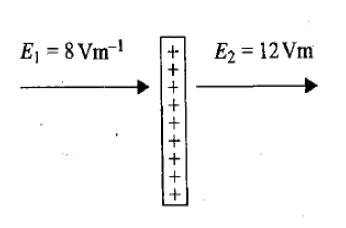Question
Question: The electric field on two sides of a large charged plate is shown in Fig. The charge density on the ...
The electric field on two sides of a large charged plate is shown in Fig. The charge density on the plate in SI units is given by (ε0 is the permittivity of free space in SI units) :

A. 2εo
B. 4εo
C. 10εo
D. zero
Solution
Electric Field is a vector quantity that exists at every point in space, electric field at a location indicates the force that would act on a unit positive test charge if placed at that location.
Complete step by step answer:
From the fig. it is clear that the plate is placed in an external electric field. Let the electric field due to plate be E, and E0 is the external electric field.
Therefore,
Eo+E=12Vm−1 ------(1)
Eo−E=8Vm−1 ----(2)
Solving equations (1) and (2), we get-
E=2Vm−1and E0=10Vm−1
Now electric field due to plate is
E=2εoσ
But E=2
So, σ=4εo
Hence, the correct answer is option (B).
Additional information:
One way to visualize the electric field (this is my mental model): Imagine a small positive test charge sticking to the end of an imaginary stick. (Make sure your imaginary stick does not behave like wood or plastic).
Explore the electric field with your test charge in different places. The test charge will be pushed or pulled through the surrounding charge.
The use of test charge (both width and direction) is divided by the value of the small test charge. The force is the electric field vector at that point. Even if you remove the test charge, there is still an electric field at that place.
Note: The electric field from the positive charge is away from the charge; Indicates the electric field charge from the negative charge. Like electrical energy, the electric field is a vector. If the electric field is known at a certain point, then the q of the ball is experienced at that point:
F=qE
If q is positive, the force is the same as the field; If q is negative, the ball is in the opposite direction of the field.
